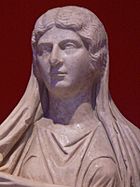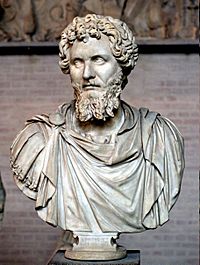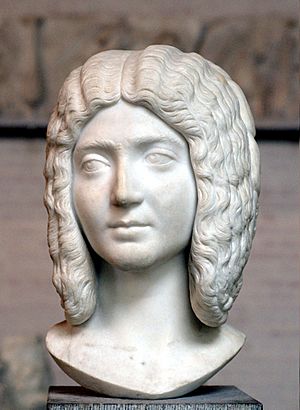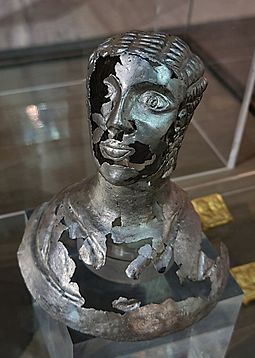Julia Maesa facts for kids
Quick facts for kids Julia Maesa |
|
|---|---|
| Augusta | |

Antoninianus of Julia Maesa
|
|
| Born | 7 May before c. 160 Emesa, Syria |
| Died | After 224 Rome, Italy |
| Spouse | Julius Avitus Alexianus |
| Issue | |
| Dynasty | Emesene and Severan |
| Father | Julius Bassianus |
Julia Maesa (born 7 May before 160 AD – died around 224 AD) was a very important woman in the Roman Empire. She was part of the Severan dynasty, a powerful family of Roman emperors.
Julia Maesa was the grandmother of two emperors, Elagabalus and Severus Alexander. She was also the older sister of Empress Julia Domna. Her daughters were Julia Soaemias and Julia Mamaea. Julia Maesa had a lot of power and influence. She was given the special title of Augusta, which meant she was a respected imperial woman. She used her influence to help her grandsons become emperors.
She was born in Emesa, Syria (which is now Homs). Her family were priests of a god called Elagabalus. Her sister, Julia Domna, married Septimius Severus, who became emperor. This made Julia Maesa the sister-in-law of an emperor and aunt to future emperors Caracalla and Geta. Julia Maesa married Julius Avitus, a Syrian man who held important government jobs. They had two daughters, Soaemias and Mamaea. These daughters later became the mothers of emperors Elagabalus and Severus Alexander.
Julia Maesa played a key role in bringing her family back to power. After her sister died, she worked hard to make her grandsons emperors. This helped the Severan dynasty return to the Roman throne. She died in Rome sometime after 224 AD. Later, she was honored as a goddess in Syria, just like her sister.
Contents
Early Life and Family
Julia Maesa was born on May 7, before 160 AD. She was the older daughter of Julius Bassianus, a priest in Emesa, Syria. Her family was part of the Emesan dynasty. Her younger sister, Julia Domna, later became a Roman empress. This happened when Julia Domna married Septimius Severus, who was a senator at the time.
Julia Maesa was from an Arab background. Her name, Maesa, comes from an Arabic word meaning "walking with a swinging gait." This was a common way for Arab poets to describe women. Coins made during her grandsons' reigns show her with strong, serious features.
Julia Maesa married Julius Avitus, who was also from Syria. He held important positions in the Roman Empire, including being a consul (a high-ranking official). They had two daughters. Their first daughter, Julia Soaemias, was born around 180 AD. Their second daughter, Julia Mamaea, was born soon after.
Life in Rome
When her sister, Julia Domna, became empress, Julia Maesa and her family moved to Rome. They lived in the imperial palace. Her husband, Julius Avitus, had many important jobs. He often traveled across the empire, but Julia Maesa stayed in Rome.
While in Rome, Julia Maesa and her family became very wealthy and powerful. They gained high positions in the Roman government. This happened during the reigns of Septimius Severus and his son, Caracalla. Both of Maesa's daughters became important figures in the court. Their husbands also held key roles as governors and consuls. Maesa's husband and her daughters' husbands moved up from a lower social rank (Equestrian) to the higher Senatorial rank.
Returning to Emesa
In 217 AD, Emperor Caracalla was killed. A new emperor, Macrinus, took the throne. Julia Maesa's sister, Domna, had lost her power and influence. She also suffered from a serious illness and had lost both her children. Because of this, she chose to end her own life.
Macrinus allowed Julia Maesa and her family to leave Rome and return to their hometown of Emesa in Syria. They had lived in Rome for about 20 years. Macrinus probably let them go because he didn't want to upset the Roman army, who were still loyal to Caracalla's memory. He also let Julia Maesa keep her great wealth. Maesa arrived in Emesa between spring 217 and spring 218.
Bringing the Severan Dynasty Back to Power
Macrinus, the new emperor, was not very popular. Soldiers were unhappy with him, especially because of a peace treaty he made with the Parthians. This gave Julia Maesa a chance to act. She was in Emesa, close to a military base. Many soldiers there still respected the Severan family. Emesa was a good place to start a plan to bring her family back to power.
Julia Maesa needed a male family member to become the new emperor. Her husband had died, as had her eldest daughter's husband. Her daughter, Julia Soaemias, had a 14-year-old son named Varius Avitus Bassianus. He was a priest of the sun god in Emesa. Soldiers from a nearby legion (Legio III Gallica) sometimes visited the temple. They found Bassianus's religious ceremonies interesting.
Julia Maesa started a plan to challenge Macrinus. She claimed that Bassianus looked a lot like Caracalla. She said he was Caracalla's son. This claim was probably not true, but it was hard to prove wrong. Julia Soaemias had lived in the Roman court when Caracalla was emperor.
Julia Maesa began offering her wealth to the Roman soldiers in Emesa. She wanted their support. News of this spread quickly through the army camps. One night, Maesa, her daughter, and Bassianus were taken into an army camp. The soldiers immediately declared the 14-year-old boy emperor. They dressed him in imperial purple robes.
The historian Cassius Dio tells a slightly different story. He mentions a young man named Gannys. Dio says Gannys was raised by Maesa and was close to Soaemias and her son. According to Dio, Gannys dressed Bassianus in clothes Caracalla wore as a child. Then, without Maesa or Soaemias knowing, Gannys took Bassianus to the army camp. He claimed Bassianus was the murdered emperor's son.
It is unlikely that Maesa and Soaemias knew nothing about Gannys's actions. They had a lot to gain if Bassianus became emperor. It is also unlikely that Maesa planned everything alone. She probably had help from important people in Emesa and even some in Rome.
Macrinus's Response
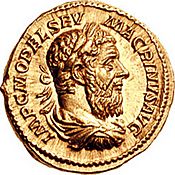
With a whole legion supporting him, other soldiers also left Macrinus and joined Elagabalus. They were unhappy about their pay. Macrinus sent his cavalry, led by Ulpius Julianus, to stop the rebels. But the cavalry killed Ulpius and joined Elagabalus instead.
After this, Macrinus went to Apamea. He wanted to make sure the Legio II Parthica was loyal to him. Then he planned to march against Emesa. Dio says Macrinus made his son Diadumenian an emperor. He also promised the soldiers a lot of money. Dio also says that Macrinus was given the head of Ulpius Julianus, who had been killed by his own soldiers. After this, Macrinus left Apamea and headed south.
Macrinus's and Elagabalus's armies met near the border of Syria Coele and Syria Phoenice. Macrinus tried to stop the rebellion, but his entire legion joined Elagabalus. Macrinus had to retreat to Antioch. Elagabalus then marched on Antioch.
The Battle of Antioch
Elagabalus's armies were led by Gannys, who was not very experienced but was determined. They fought Macrinus's Praetorian Guard in a big battle. Gannys had more soldiers, at least two full legions. Macrinus had ordered his Praetorian Guard to wear lighter armor. This made them faster. The Praetorian Guards broke through Gannys's lines, and his troops started to run away.
But then, Julia Maesa and Soaemias did something very brave. They jumped from their chariots and rallied the fleeing soldiers. Gannys also charged into the enemy on horseback. These actions stopped the retreat. The troops fought again with new courage, turning the battle around. Fearing defeat, Macrinus fled back to Antioch. He tried to escape north but was caught and killed in Cappadocia. His son, Diadumenian, was also captured and killed.
Elagabalus entered Antioch as the new emperor of Rome. He stopped his soldiers from looting the city. He sent a message to the Roman Senate, who had to accept him as their new emperor. He took the name Marcus Aurelius Antoninus Augustus.
Elagabalus's Reign
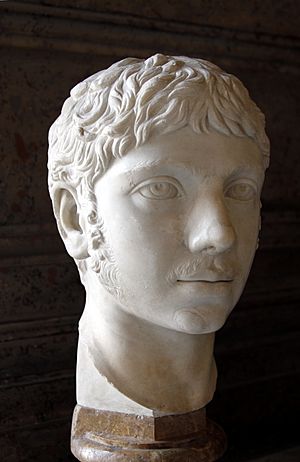
Even though Elagabalus was now emperor, others still tried to claim the Roman throne. These included Verus, a commander who had first supported Elagabalus, and Gellius Maximus. These rebellions were quickly put down, and their leaders were executed.
Elagabalus spent the winter of 218–219 in Nicomedia before traveling to Rome. Maesa reportedly wanted him to enter Rome dressed in traditional Roman clothes. Instead, he had a painting made of himself as a priest making offerings to the Emesan god El-Gabal. This painting was hung above the statue of Victoria in the Senate. This made senators have to make offerings to the Syrian god whenever they wanted to honor Victoria.
Both Julia Maesa and her daughter Soaemias were very important during Elagabalus's rule. They had a lot of influence over the young emperor. Julia Maesa received special titles, like 'Augusta, mother of the camp and the senate' and 'grandmother of the emperor'. She and Soaemias were given senatorial titles. They even appeared in the Senate next to Elagabalus when he adopted Severus Alexander. This was a very rare honor for imperial women.
Soon, the young emperor started to lose favor with the Praetorian Guards. They did not approve of his behavior or his unusual religious practices. Their support was vital for his rule. Julia Maesa decided to act. She disagreed with some of his choices. She convinced her grandson to adopt his cousin, her other grandson Alexander. She argued that this would give Elagabalus more time for religious matters. Alexander was 12 years old. His adoption gave Elagabalus's supporters another option, as some felt it was no longer wise to fully support the priest-emperor.
A rivalry grew between the two boys. Elagabalus regretted adopting his more popular cousin. Soldiers started to favor Alexander. The imperial family and their supporters became divided. Elagabalus and Soaemias were on one side, while Mamaea, Maesa, and Alexander were on the other.
By early 222, Alexander and Elagabalus were so distant that they no longer appeared together in public. Elagabalus tried to have Alexander killed. This made the Praetorian Guards very angry. They demanded that Elagabalus promise Alexander's safety and fire certain officials. Elagabalus broke his promise. The Praetorian Guard then killed Elagabalus and his mother. Alexander was then declared emperor.
It is often believed that Julia Maesa and her daughter were the ones truly running the state, while Elagabalus focused on religion. However, some historians say that in ancient Rome, politics and religion were closely linked. Elagabalus's rule broke this connection. It is clear that Maesa had influence over him. But Elagabalus often ignored Maesa's advice, especially her suggestions to follow Roman traditions. This is seen as a main reason for his downfall.
Julia Maesa might have been involved in the killing of her daughter and grandson, or at least she allowed it to happen. This action may have helped her family keep power and keep the empire stable.
Severus Alexander's Reign
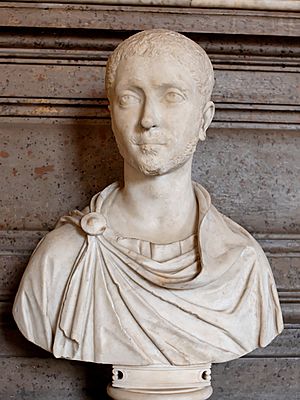
Alexander became emperor when he was about 14 years old. His mother and grandmother guided him. They wanted to fix the bad impression left by Elagabalus's rule. Alexander was given the name Marcus Aurelius Severus Alexander. This name highlighted his connection to Septimius Severus, who started the dynasty.
Julia Mamaea and Julia Maesa helped manage the empire while Alexander was young. Official writings mentioned Alexander as "the son of Julia Mamaea and grandson of Julia Maesa." This showed their high status. Maesa and her daughter made changes. They chose a council of sixteen experienced people to advise the young emperor. This helped restore a more traditional and fair government.
Under the new rule, Elagabalus's policies were reversed. The eastern religious practices he brought to Rome were stopped. The sacred stone of El-Gabal was sent back to Emesa. The large temple Elagabalus built for his god was rededicated to Jupiter.
Death and Honor
Maesa probably died between November 224 and 227 AD. Her death was a great loss for her daughter, Julia Mamaea. Mamaea lost her mother and her political advisor. She was now alone in guiding her son's rule.
Honored as a Goddess
Like her sister Julia Domna, Julia Maesa was honored as a goddess after her death. In an ancient list of religious events from around 227 AD, Maesa is mentioned. People would pray to her on her birthday (May 7). Coins made to remember her deification show her being carried up to the sky on the back of a peacock. She also appears as a goddess in another official record from November 7, 224 AD.
Severan dynasty family tree
|
|||||||||||||||||||||||||||||||||||||||||||||||||||||||||||||||||||||||||||||||||||||||||||||||||||||||||||||||||||||||||||||||||||||||||||||||||||||||||||||||||||||||||||||||||||||||||||||||||||||||||||||||||||||||||||||||||||||||||||||||||||||||||||||||||||||||||||||||||||||||||||||||||||||||||||||||||||||||||||||||||||||||||||||||||||||||||||||||||||||||||||||||||||||||||||||||||||||||||||||||||||||||||||||||||||||||||||||||||||||||||||||||||||||||||||||||||||||||||||||||||||||||||||||||||||||||||||||||||||||||||||||||||||||||||||||||||||||||||||||||||||||||||||||||||||||||||||||||||||||||||||||||||||||||||||||||||||||||||||||||||||||||||||||||||||||||||||||||||||||||||||||||||||||||||||||||||||||||||||||||||||||||||||||||||||||||||||||||||||||||||||||||||||||||||||||||||||||||||||||||||||||||||||||||||||||||||||||||||||||||||||||||||||||||||||||||||||||||||||||||||||||||||||||||||||||||||||||||||||||||||||||||||||||||||||||||||||||||||||||||
Notes:
Bibliography:
|
|||||||||||||||||||||||||||||||||||||||||||||||||||||||||||||||||||||||||||||||||||||||||||||||||||||||||||||||||||||||||||||||||||||||||||||||||||||||||||||||||||||||||||||||||||||||||||||||||||||||||||||||||||||||||||||||||||||||||||||||||||||||||||||||||||||||||||||||||||||||||||||||||||||||||||||||||||||||||||||||||||||||||||||||||||||||||||||||||||||||||||||||||||||||||||||||||||||||||||||||||||||||||||||||||||||||||||||||||||||||||||||||||||||||||||||||||||||||||||||||||||||||||||||||||||||||||||||||||||||||||||||||||||||||||||||||||||||||||||||||||||||||||||||||||||||||||||||||||||||||||||||||||||||||||||||||||||||||||||||||||||||||||||||||||||||||||||||||||||||||||||||||||||||||||||||||||||||||||||||||||||||||||||||||||||||||||||||||||||||||||||||||||||||||||||||||||||||||||||||||||||||||||||||||||||||||||||||||||||||||||||||||||||||||||||||||||||||||||||||||||||||||||||||||||||||||||||||||||||||||||||||||||||||||||||||||||||||||||||||||
See also
 In Spanish: Julia Mesa para niños
In Spanish: Julia Mesa para niños


